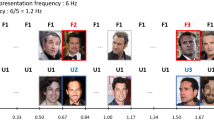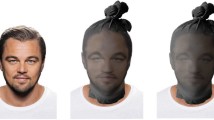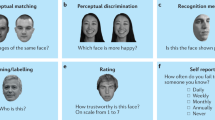Abstract
Skin Conductance Responses (SCRs) to familiar and unfamiliar names and faces were recorded from independent groups of subjects, using two different presentation designs: the first employing fewer familiar than unfamiliar items (Tranel, Fowles, and Damasio, 1985) and the second employing equal numbers of familiar and unfamiliar items. In both designs, familiar faces were responded to significantly more strongly than unfamiliar faces, whereas for names there was no difference in responses to familiar and unfamiliar stimuli. Faces produced significantly larger overall SCRs than names in the unequal familiar/unfamiliar ratio design, but this effect was not observed in the equal ratio design. The results are discussed with particular reference to those previously published by Tranel et al. (1985) and in relation to work both on covert recognition in prosopagnosia and on one of the delusional misidentification syndromes known as the Capgras delusion.
Similar content being viewed by others
References
Bauer, R.M. (1984). Autonomic recognition of names and faces: A neuropsychological application of the Guilty Knowledge Test. Neuropsychologia, 22,457–469.
Bruce, V. and Young, A. (1986). Understanding face recognition. British Journal of Psychology, 77, 305–327.
Bruce, V. (1988). Recognizing Faces. Hillsdale, N.J.: Lawrence Erlbaum Associates.
Burton, A.M., Bruce, V., and Johnston, R.A. (1990). Understanding face recognition with an interactive activation model. British Journal of Psychology, 81,361–380.
Burton, A.M., Young, A.W., Bruce, V., Johnston, R. and Ellis, A.W. (1991). Understanding covert recognition. Cognition, 39, 129–166.
Damasio, A.R., Damasio, H., and Van Hoesen, G.W. (1982). Prosopagnosia: Anatomic basis and behavioral mechanisms. Neurology, 32,331–341.
Dawson, M.E., Schell, A.M., and Filion, D.L. (1990). The electrodermal system. In T. Cacioppo and L.G. Tassinary (Eds.), Principles of Psychophysiology, pp. 295–324. New York: Cambridge University Press.
de Pauw, K.W. (1994). Psychodynamic approaches to the Capgras delusion—A historical review. Psychopathology, 27,154–160.
Ellis, H.D. (1975). Recognizing faces. British Journal of Psychology, 409-426.
Ellis, H.D. (1981). Introduction. In G.M. Davies, H.D. Ellis and J.W. Shepherd. Perceiving and Remembering Faces. London: Academic Press.
Ellis, H.D. (1986). Processes underlying face recognition. In R. Bruyer (Ed), The Neuropsychology of Face Perception and Facial Expression. Hillsdale, N.J.: Lawrence Erlbaum.
Ellis, H.D and Young, A.W. (1990). Accounting for delusional misidentifications. British Journal of Psychiatry, 157, 239–248.
Ellis, H.D., Young, A.W., and Koenken, G. (1993). Covert face recognition without prosopagnosia. Behavioural Neurology, 6,27–32.
Ellis, H.D., Young, A.W., Quayle, A.H., and de Pauw, K.W. (1997). Reduced autonomic responses to faces in Capgras delusion. Proceedings of the Royal Society, London B, 264, 1085–1092.
Fowles, D.C., Christie, M.J., Edelberg, R., Grings, W.W., Lykken, D.T. and Venables, P.H. (1981). Publication recommendations for electrodermal measurements. Psychophysiology, 18,232–239.
Goldstein, A.G. and Chance, J.E. (1971). Visual recognition memory for complex configurations. Perception and Psychophysics, 9,237–241.
Hirstein, W. and Ramachandran, V.S. (1997). Capgras syndrome: A novel probe for understanding the neural representation of the identity and familiarity of persons. Proceedings of the Royal Society, London B, 264,437–444.
Kirk, R.E. (1968). Experimental Design: Procedures for the Behavioural Sciences. Belmont, California: Brooks/Cole Publishing Company.
Prokasy, W.F. and Kumpfer, K.L. (1973). Classical conditioning. In W.F. Prokasy and D.C. Raskin (Eds.), Electrodermal Activity in Psychological Research (pp. 157–202). New York: Academic Press.
Tranel, D. and Damasio, A.R. (1988). Non-conscious face recognition in patients with face agnosia. Behavioural Brain Research, 30, 235–249.
Tranel, D., Fowles, D.C, and Damasio, A.R. (1985). Electro-dermal discrimination of familiar and unfamiliar faces: A methodology. Psychophysiology, 22,403–408.
Van Lancker, D. (1991). Personal relevance and the human right hemisphere. Brain and Cognition, 17, 64–92.
Venables, P.H. and Christie, M.J. (1980). Electrodermal activity. In I. Martin and P.H. Venables (Eds.), Techniques in Psychophysiology (pp. 3–67). New York: Wiley and Sons.
Young, A.W. and Ellis, H.D. (1989). Childhood prosopagnosia. Brain and Cognition, 9, 16–47.
Author information
Authors and Affiliations
Additional information
This study was carried out with generous support from the EJLB Foundation (Canada) and the Wellcome Trust.
Rights and permissions
About this article
Cite this article
Ellis, H.D., Quayle, A.H. & Young, A.W. The emotional impact of faces (but not names): Face specific changes in skin conductance responses to familiar and unfamiliar people. Curr Psychol 18, 88–97 (1999). https://doi.org/10.1007/s12144-999-1018-y
Issue Date:
DOI: https://doi.org/10.1007/s12144-999-1018-y




